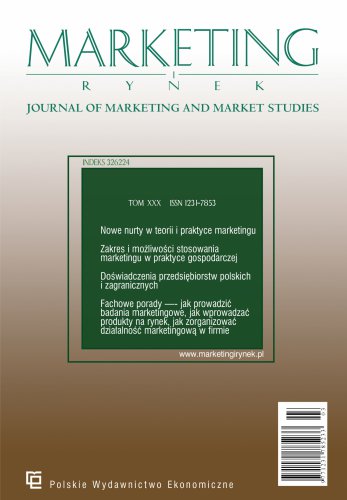Digital inclusion vs. disconnection of social media – generation BB vs. generation Z
Access to Internet resources is a key prerequisite for taking advantage of the opportunities offered by the global web. It is also important to have the skills as well as a positive attitude to really benefit from their use. This represents an advantage in the phenomenon of digital inclusion, in which the older generations are systematically "catching up" with the younger ones. At the same time, however, a completely different trend is observed, consisting of limiting Internet use for reasons of security, protection of one's own health or the desire to build social relations in a traditional, nondigital way. The aim of this article is to compare the state of occurrence of both these phenomena in two age groups belonging to generations BB (baby boomers, 65–74 years old) and Z (16–29 years old), using the example of one of the most expansive network solutions – social media (SM). A statistical descriptive method and individual semi-structured interviews were used. The results show that although the differences in access to network services are steadily decreasing, they remain consistently high for SM. Z and BB use SM differently and in different ways – for generation Z they are a source of interesting content and a medium of communication, for BB – a source of information. Conclusions: the technological environment continues to differentiate between generations in terms of access, while the reasons for limiting the use of SM are two and they are common – time and usefulness of information. The research has the character of the first, preliminary research diagnosing the occurrence of the new phenomenon of disconnection of social media in Poland.
References
Bibliografia/References
Andrałojć, M., & Ławrynowicz, M. (2012). Elastyczny system wynagrodzeń w motywowaniu pokolenia Y. Zarządzanie Zasobami Ludzkimi, 5(88), 49–62.
Borowik, M., Maśniak, L., Kroplewski, R., & Romaniec, H. (2018). Przemysł+. Gospodarka oparta o dane. Ministerstwo Cyfryzacji. https://kometa.edu.pl/uploads/publication/825/9a26_AA_Gospodarka%20Oparta%20o%20Dane_05.01.2018.pdf?v2.8 (dostęp: 12.09.2022).
Castells, M. (2001). The Internet Galaxy: Reflection on the Internet, Business, and Society. Oxford University Press.
Chan, S. S., Van Solt, M., Cruz, R. E., Philp, M., Bahl, S., Serin, N., Amaral, N. B., Schindler, R., Bartosiak, A., Kumar, S., & Canbulut, M. (2022). Social media and mindfulness: From the fear of missing out (FOMO) to joy of missing out (JOMO). Journal of Consumer Affairs, 56(3), 1312–1331. https://doi.org/10.1111/joca.12476
Dąbrowska, A., Janoś-Kresło, M., & Mróz, B. (2020). Zachowania osób starszych na rynku e-usług. Oficyna Wydawnicza SGH.
van Dijk, J., & Hacker, K. (2003). The digital divide as a complex and dynamic phenomenon. The Information Society, 19(4), 315–326. https://doi.org/10.1080/01972240309487
Eitan, T., & Gazit, T. (2023). No social media for six hours? The emotional experience of meta„s global outage according to FoMO, JoMO and internet intensity. Computers in Human Behavior, 138, 107474. https://doi.org/10.1016/j.chb.2022.107474
Empemedia. (2022). Internet i social media w Polsce 2022 – raport. https://empemedia.pl/internet-i-social-media-w-polsce-2022-raport/ (dostęp: 16.01.2023)
Eurostat. (2022a). Individuals – internet use. https://ec.europa.eu/eurostat/databrowser/view/ISOC_CI_IFP_IU__custom_4614064/default/table?lang=en (dostęp: 28.12.2022).
Eurostat. (2022b). Individuals – internet activities. https://ec.europa.eu/eurostat/databrowser/view/ISOC_CI_AC_I__custom_4611786/default/table?lang=en (dostęp: 29.12.2022).
Eurostat. (2022c). Individuals – internet activities. https://ec.europa.eu/eurostat/databrowser/view/ISOC_CI_AC_I__custom_4612022/default/table?lang=en (dostęp: 17.12.2022).
Eurostat. (2022d). Security related problems experienced when using the internet. https://ec.europa.eu/eurostat/databrowser/view/ISOC_CISCI_PB/default/table?lang=en (dostęp: 30.05.2023).
Frąckiewicz, E. (2020). Seniorzy jako uczestnicy mediów społecznościowych i twórcy ich treści. W: E. Frąckiewicz, & B. Kryk (Red.), Srebrna gospodarka. Ujęcie społeczno-ekonomiczne (201–216). CeDeWu.
Gangneux, J. (2019). Logged in or locked in? Young adults’ negotiations on social media platforms and their features. Journal of Youth Studies, 22(8), 1053–1067. https://doi.org/10.1080/13676261.2018.1562539
Grabiwoda, B. (2018). E-konsumenci jutra. Pokolenie Z i technologie mobilne. Wydawnictwo Nieoczywiste.
Hajduk, G. (2019). Zarządzanie komunikacją marketingową. Integracja. Nowe media. Outsourcing. Poltext.
Jaciow, M., & Wolny, R. (2022). Polski e-konsument. Dekada zmian. Helion.
Kall, J. (2015). Branding na smartfonie. Wolters Kluwer.
Kaplan, A. M., & Haenlein, M. (2010). Users of the world, unite! The challenges and opportunities of social media. Business Horizons, 53(1), 59–68. https://doi.org/10.1016/j.bushor.2009.09.003
Katz, J. E., & Aspden, P. (1998). Internet dropouts in the USA: The invisible group. Telecommunications Policy, 22(4–5), 327–339. https://doi.org/10.1016/S0308-5961(98)00013-5
Katz, S. (2017). Generation X: A critical sociological perspective. Journal of the American Society on Aging, 41(3), 12–19.
Kobylińska, U., & Płoszczuk, E. (2021). Media społecznościowe w kształtowaniu wizerunku pracodawcy (w opinii różnych pokoleń). Marketing i Rynek, (12), 28–39. http://dx.doi.org/10.33226/1231-7853.2021.12.3
Levickaite, R. (2010). Generations H, Y, Z: How social networks form the concept of the world without borders (the case of Lithuania). Limes, 3(2), 170–183. http://dx.doi.org/10.3846/limes.2010.17
Marston, H. R., Kroll, M., & Fink, D. (2016). Technology use, adoption and behavior in older adults: Results from the iStoppFalls project. Educational Gerontology, 42(6), 371–387. https://psycnet.apa.org/doi/10.1080/03601277.2015.1125178
Mazurek, G. (2019). Transformacja cyfrowa. Perspektywa marketingu. Wydawnictwo Naukowe PWN.
McCrindle. (b.d.). Understanding Generation Alpha. https://mccrindle.com.au/article/topic/generation-alpha/generation-alpha-defined/ (dostęp: 26.11.2022).
Mróz, B. (2013). Konsument w globalnej gospodarce. Trzy perspektywy. Oficyna Wydawnicza SGH.
Nguyen, M. H., Hargittai, E., Fuchs, J., Djukaric, T., & Hunsaker, A. (2021). Trading spaces: How and why older adults disconnect from and switch between digital media. The Information Society, 37(5), 299–311. https://doi.org/10.1080/01972243.2021.1960659
OECD. (2001). Understanding the Digital Divide. https://www.oecd.org/digital/ieconomy/1888451.pdf (dostęp: 14.06.2022).
Sarowski, Ł (2017). Od Internetu Web 1.0 do Internetu Web 4.0 – ewolucja form przestrzeni komunikacyjnych w globalnej sieci. Rozprawy Społeczne, 11(1), 32–39. https://doi.org/10.29316/rs.2017.4
Turner, A. (2015). Generation Z: technology and social interest. The Journal of Individual Psychology, 71(2), 103–113. https://doi.org/10.1353/jip.2015.0021
Van Den Bergh, J., & Behrer, M. (2011). Jak kreować marki, które pokocha pokolenie Y. Wydawnictwo Samo Sedno.

